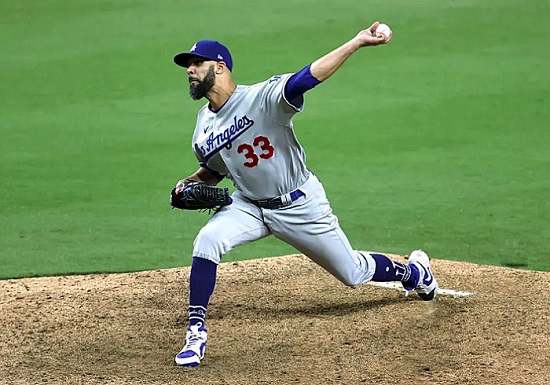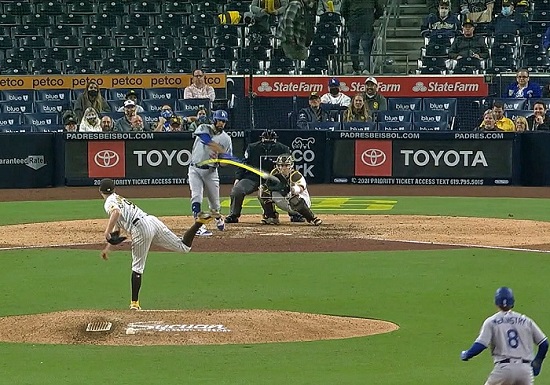A little over 24 hours after 35-year-old left-hander David Price recorded the first save in his brilliant 13-year MLB career, he notched his first (of 151) win in a Dodger uniform … and it was glorious.
In a game that was three minutes shy of five hours long and saw a combined 17 pitchers used, it was the 6′-5″ / 215-pound Murfreesboro, TN native and first overall pick in the 2007 MLB draft out of Vanderbilt by the (then) Tampa Bay Devil Rays who prevailed.
“It was really cool,” Price said of his first win as a Dodger – out of the bullpen or otherwise. “I haven’t been in that situation very many times where, I guess I’ve never given up a walk-off, you know. So to kind of be out there in that situation and be able to make pitches … the 11th inning, the first guy grounded out, I got [Eric] Hosmer – he’s had success against me, he’s hit the ball hard in previous at-bats – to make pitches against him, that was really cool.”

(Photo credit – Sean M. Haffey)
Price also drove in a crucial insurance run with a sacrifice fly in the top of the 12th inning of what had become a 6-6 tie in the bottom of the ninth.
“That was cool,” Price said about his prowess with the bat. “I still got my… my hit streak is intact still – it’s 0-for-0 – so, I’m two for my last three in the regular season and three for my last four if you include Spring Training.”

Although Dodgers manager Dave Roberts is still in right-hander Kenley Jansen‘s corner as his primary closer, Jansen was ineffective on Friday night. After Dodgers right-hander Corey Knebel blew the save in the bottom of the eighth inning, the Dodger scored a run in the top of the ninth to retake the lead. But in the bottom of the ninth, Jansen allowed the tying run to score to send the game into extras innings.
“I thought Kenley threw the heck out of the baseball,” Roberts said postgame, very well aware of the scrutiny that Jansen is under by fans and the media. “He went one-plus, got us out of that jam [in the bottom of the eighth inning]. I thought he threw the ball extremely well. I’m very proud of him, and he did everything we asked of him.”
Well … except, perhaps, for that tying run thing. It’s no secret that the 33-year-old Willemstad, Curacao native has struggled – considerably – over the past two seasons. But even with his second blown save on Friday night, he still has a 2.57 ERA through his first six games this season and owns an outstanding 2.39 career ERA over his 12 major league seasons – all with the Dodgers. That being said, he becomes a free agent at the end of this season. Price, on the other hand, is under contract through the 2022 season.
Although Roberts is still very much committed to Jansen and his number one closer, if Price continues to do what he has been doing of late, one has to believe that Kenley’s days as his number one closer could be numbered.
Stay tuned…
* * * * * *




 April 17th, 2021 at 10:30 am
April 17th, 2021 at 10:30 am  by Ron Cervenka
by Ron Cervenka  Posted in
Posted in 

I wonder how long the Dodger bats can keep saving Roberts’s butt after continuously making stupid decisions. How long is he going to have faith in Jansen who has become a question mark every time he is brought in?
Monsieur Maurice: Maybe you should try a baseball psycho analysis(?). Maybe YOU perceive that Jansen has become “a question mark every time he is brought in” because of torture in your childhood. Such as last year… Jansen and Treinin have exactly the same ERA (2.57 they both have allowed 2 runs in 7 innings). If we were going to be talking about the ‘disaster’ on Friday night it was the “meltdown” by last week’s closer candidate, Knebel, who saw his ERA rise from 0.00 to 3.00 in a single outing. The ‘invincible’ David Price still has a 5.87 ERA. Victor Gonzalez is the only reliever with an ERA lower than Jansen and Treinen… So the least one can say is that the arguments against Jansen are not clear cut…
Nice article Ron, I like what I see from Price so far but I want to see more from him before I would turn the closer roll over to him, plus like you said Roberts is committed to Jansen.
According to Friday’s box score it was Knebel who was charged with the blown save.
You are correct, Joe, Kenbel was charged with a blown save for giving up the tying run in the bottom of the eighth. But because the Dodgers scored in the top of the ninth and because Jansen gave up the tying run in the bottom of the ninth, he, too, should have been charged with a blown save, as you can have more than one blown save in a game (the MLB record is four).
Here is the definition of a Blown Save from the official MLB Glossary of Terms (verbatim):
———————————————————————————————————————
Blown Save (BS)
Definition: A blown save occurs when a relief pitcher enters a game in a save situation, but allows the tying run to score. The run does not have to be charged to that pitcher. If a reliever enters with a man already on third base, and he allows that runner to score the tying run, he is charged with a blown save.
Although many blown saves occur in the ninth inning or later, they aren’t limited to the ninth inning. If a pitcher enters in the eighth inning and surrenders the tying run in a save situation, he is given a blown save — regardless of whether he pitches the ninth. A pitcher can still receive either a win or a loss (or a no-decision) after recording a blown save, depending on the ensuing results.
Blown saves are used as a tool to evaluate the effectiveness of a closer. However, not all blown saves are created equal — after all, entering with a three-run lead in the ninth and entering with a one-run lead and a man on third in the eighth are both considered save situations. It’s important to remember this when assessing closers based on their blown saves.
Origin: Blown saves were introduced as a statistic in 1988 as a counterbalance for the statistic “saves.”